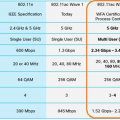The road of TV shown as follow:
1) Regular TV / Analog TV
2) SDTV
3) EDTV
4) HDTV
SDTV (480i)
SDTV shows the digital signal in 480i, which means 480 lines of the video are drawn on the screen using the interlaced method. Interlaced refers to the way the signal is sent and how the TV displays it. The advantage to SDTV over your regular, analog TV (which is also 480i) is twofold:
SDTV is digital (clearer, crisper picture)
SDTV accepts digital programming (i.e., the FCC has mandated that eventually all broadcasts will be sent in one of the digital formats created by the ATSC, American Television Systems Committee).
EDTV (480p)
EDTV is defined as 480p, which stands for the 480 lines of the screen are used to draw the picture using the progressive scanning method. You may have heard of progressive in reference to DVD players – progressive scan DVD players have become standard.
Progressive scanning means that all of the lines in the frame of the video are painted onto the screen in sequential order (1, 2, 3, 4, … up to 480) at one time. Compared to the numbers connected with HDTV (1080i or 720p), 480p might not sound all that great, but progressive scanning creates a cleaner, crisper picture because it’s displayed at one time. Therefore, even though the number is the same as SDTV (480), the method used to put it on your TV screen uses the more advanced technique (progressive scanning).
HDTV Technology is complex with numerous benefits to broadcasters and program providers, but the value to the viewer can be reduced to three things:
Resolution
The crisp, life-like detail you see with HDTV is due to the resolution this technology provides. It’s like the difference between the old dot matrix printers and the laser printers we use now.
The picture you see on your TV screen is actually thousands of small dots, called pixels (which stands for picture elements). Your regular, analog TV displays about 200,000 pixels. HDTV displays 1 million to 2 million pixels (up to 10 times the resolution of the picture on a regular TV).
Currently, digital TV broadcasters have been using two different formats for sending HDTV – 1080i (interlaced) and 720p (progressive). It doesn’t really matter which format the broadcaster uses (1080i or 720p), because most people can’t even tell the difference when they’re watching HDTV.
Aspect Ratio
Aspect ratio is simply the proportion of the width of the TV screen to the height of the TV screen. Regular TVs use a 4×3 aspect ratio, which means the picture is a little wider than it is tall (a screen that is 20 inches wide is about 15 inches tall).
HDTV uses the widescreen (16×9) aspect ratio used in the film industry. Therefore, the TV that is 15 inches tall would be 27 inches wide.
The widescreen format provides a more compelling viewing experience because it mimics our peripheral vision – our field of vision is much wider than it is tall. Additionally, you get to see more of the action.
Digital Signal and Sound
Digital signals can be compressed, enabling a much more robust signal with no variation in quality. Digital signals, in contrast to analog signals that are used with regular TVs, can be reproduced precisely because they use the sames 1s and 0s that are used with computers. Therefore, you won’t see ghosting, snow or fuzziness with a digital signal.


